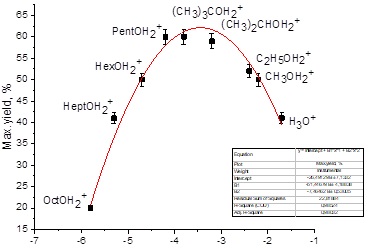Obtaining Cellulose Nanocrystals in a Medium of Primary Monohydric Alcohols
DOI:
https://doi.org/10.31489/2959-0663/4-24-1Keywords:
cellulose microparticles, alcohols, cellulose, cellulose nanocrystals, synthesis, hydrolysis, alcoholysis, yield, propertiesAbstract
The lack of a universal method for isolating cellulose nanocrystals (CNCs) has encouraged researchers to look for new methods and approaches as alternatives to traditional sulfuric acid hydrolysis. Acid alcoholysis has long been actively used in cellulose depolymerization processes to obtain a variety of alkyl glycosides and further alcoholysis products. In the present article, the authors continue their earlier research on the synthesis of CNCs in the presence of a sulfuric acid catalyst in an alcoholic environment. In this work, CNCs were obtained from sulfate-bleached pulp in a medium of primary monohydric alcohols (СnH2n+1OH,
n = 5–8). A maximum CNC yield of 60 % was achieved with pentanol-1 at a sulfuric acid concentration of 50 %. The work revealed that the alcohols studied can be ranked in descending order based on both the acid concentration corresponding to the maximum CNC yield and the yield itself, as follows: pentanol-1, hexanol‑1, heptanol-1, and octanol-1. For octanol-1 the maximum CNC yield was 20 % at an acid concentration of 40 %. The physicochemical properties of the isolated CNCs were studied. No surface alkylation of the synthesized CNCs was found to occur during cellulose treatment in the media of the alcohols studied, as the properties of the CNCs, in general, were similar to those of CNCs obtained by standard sulfuric acid hydrolysis. This study broadens the scope of alternative methods to traditional sulfuric acid hydrolysis, and is likely to appeal to researchers engaged in developing novel approaches for CNC extraction.

Downloads
Published
How to Cite
Issue
Section
License
Copyright (c) 2024 Oleg V. Surov, Marina I. Voronova

This work is licensed under a Creative Commons Attribution-NonCommercial-NoDerivatives 4.0 International License.
This work is licensed under a Creative Commons Attribution-NonCommercial-NoDerivatives 4.0 International License.
Authors retain copyright and grant the journal right of first publication with the work simultaneously licensed under a Creative Commons Attribution License (CC BY-NC-ND 4.0) that allows others to share the work with an acknowledgement of the work's authorship and initial publication in this journal.



